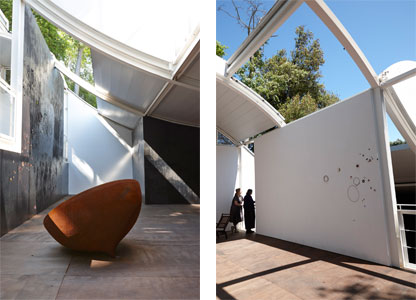 |
||||
|
||||
|
||||
ARTEXT : La Biennale di Venezia
HERE ART GROWS on TREES
The exhibition project, Here art grows on trees, presents Gill's works on paper as being of vegetation, as a cog in the whole system of turning wheels, as just a link in the chain, in the string of gems that the world is offering a cyclic instead of linear world-view. Originating from pulp made of decayed plants, the works will slowly return to the vegetal, in an organic cycle from foliage to folio to foliage. Gill's project is about entropy, the passage through time: paper's passage, the work's passage, the pavilion's passage, the artist's passage. Working the world out through analogies and comparisons makes the most sense to me ... And it comes from an understanding of knowing oneself as being nothing: empty and invisible like the wind, or water. With no substance as it were, to claim any kind of certainty and truth. It's my strength and it's my weakness. If you think of yourself as not being substantial, then you will understand yourself and the world at large, through the things around you, by comparing, by holding them next to each other and yourself, above and below, besides, together, arranged and jumbled ... If you are empty, nothing, you only exist through the things around you, and if these things shift in their qualities and values, in relation to you, each other and other things, then the sense of self is always moving too. And the other way around: when I am the vector that is moving, then the things around me change, and my relationship to them too, how I do or don't connect, comprehend, sympathise. These are the un-static beacons we use to navigate through daily being. (Simgn Gill quoted from an unpublished text, 2012) In Gill's practice, this sense of metaphysical alienation is exacerbated by the physical, geographical dispossession of the migrant. Doubly dislodged, she like every woman must inevitably find that she has no home, no where. When she first arrived to live in Sydney, she made an embroidered sampler with the question Who am I? repeated in many different fonts. Cixous writes: What is my place if I am a woman? I look for myself throughout the centuries and don't see myself anywhere. Perhaps women must be displaced to be re-placed. Like the industrious insects, so abundant in the tropics, the ants, bugs, beetles, bees, flies, silverfish and crickets in Gill's collaged drawings traced by pen with Indian Ink (or Encre de Chine) and with torn-out words and text fragments from book pages we must fly away to be regenerated. Gill considers her work as a process of how to be in a new place, in the real world and habitation as a present state of engagement: almost like a regular talking of oneself into existence in a place. For her, plants and the plant world offer a powerful way to think about where we find ourselves now and how we grow into and adapt to our sense of place. In her touching upon the roots of being, the roots of words within symbolic structures that come with language in the interstices the drawn-out insects become her allies in the recent large paperwork Let Go, Lets Go. Together they possess a threatening semiotic/symbolic mobility, as they fly off the page, off the sheet of paper. Gill shows us the signs in the everyday that we don't see any longer, as if to teach us, to educate us how to read the daily signs and their meanings again in the world at large. At the same time, like a fragile ecosystem, the everyday is highly vulnerable to the depredations of invasive, manipulative forces or pressures (both inner and outer), and this is exacerbated by our fear of allowing our lives to be reduced to the everyday, which drives us to flee such vacancy. The banal everyday thus contains its own antidote.
Web site:http://www.venicebiennale.australiacouncil.gov.au/ |
||||
Artext © 2013 |
